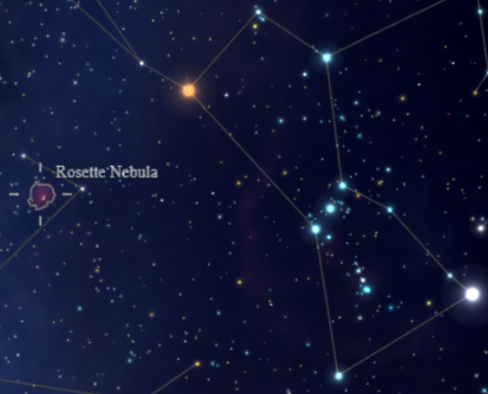The Rosette Nebula
Belleville, MI
02/05/25
The Rosette Nebula (Caldwell 49 / NGC 2237–2246) – A Bloom of Starbirth in Monoceros
Visible to the east of the iconic constellation of Orion, the Rosette Nebula is a vast and beautiful emission nebula located in the constellation Monoceros, the Unicorn, near the border with Orion. Resembling the delicate petals of a cosmic rose, the nebula is an immense star-forming region sculpted by the powerful winds and radiation of its central star cluster. Glowing with hydrogen, oxygen, and sulfur emissions, the Rosette Nebula stands as a radiant example of the life cycle of stars and the sculpting of interstellar gas.
Distance and Size
- Distance: ~5,200 light-years
- Apparent Size: ~1.3° across (more than 2.5 full Moons)
- Actual Size: ~130 light-years in diameter
Despite its vast size, the Rosette Nebula has a relatively low surface brightness, requiring long-exposure imaging or dark skies and filters to reveal its full structure.
Structure and Components
The Rosette Nebula is part of a giant molecular cloud complex that includes multiple catalog entries:
- NGC 2237–2239: portions of the emission nebula
- NGC 2244: the central open star cluster
- NGC 2246: dense regions of star formation
The nebula’s iconic flower-like shape is the result of stellar feedback—intense ultraviolet radiation and stellar winds from the central young stars ionize the surrounding gas and carve out a vast central cavity, surrounded by a glowing ring of compressed gas and dust.
Central Cluster – NGC 2244
At the heart of the Rosette Nebula is NGC 2244, an open star cluster formed from the nebula’s material just a few million years ago.
- Age: ~2–4 million years
- Dominant Stars: Several O-type and B-type stars
- Key Ionizing Star: HD 46223, an O4V star
- Surface Temperature: ~43,000 K
- Luminosity: ~400,000 times that of the Sun
These massive young stars emit intense ultraviolet radiation, ionizing the surrounding hydrogen gas and causing the nebula to glow in the deep red hues typical of H-alpha emission. Their stellar winds, moving at thousands of kilometers per second, have blown a bubble into the surrounding gas, shaping the nebula’s hollow core about 30 light years in diameter, and triggering secondary waves of star formation in the surrounding shell.
Star Formation and Scientific Significance
The Rosette Nebula is a stellar nursery, rich with protostars, dark globules, and young stellar objects (YSOs). Infrared and submillimeter observations reveal:
- Hundreds of embedded protostars
- Dense molecular filaments and clumps where new stars are forming
- Evidence of radiation-driven implosion, where massive stars compress nearby gas clouds into new stars
The region is a textbook example of sequential star formation, where the energy from one generation of stars triggers the next.
EASILY SEEN IN THIS IMAGE ARE THE EMISSION LINES OF IONIZED GAS:
- Hydrogen-alpha (Hα): deep red, tracing ionized hydrogen
- [O III]: teal-blue, highlighting high-energy regions
- [S II]: deep orange-red, outlining shock fronts and dense clumps
The Rosette Nebula is a grand and poetic example of the life cycle of stars, from birth in dense clouds to energetic young clusters shaping their environment. At over 5,000 light-years away and spanning 130 light-years, this glowing flower in Monoceros is more than just beautiful—it’s an active stellar factory, offering astronomers a detailed view of how stars form, evolve, and influence the galaxy around them. Whether seen visually through binoculars or captured in stunning detail with a telescope and camera, the Rosette is one of the most enchanting jewels of the winter sky.
Project Details
-
Belleville, MI
-
ZWO FF65 telescope FL=416 mm, f6.4, Pentax K3ii, 40 second subs, iso 1600, 3h40m integration time



